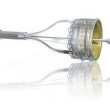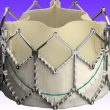At 5 years, there were no differences in all-cause death, stroke, acute myocardial infarction, or all of these combined between low-risk, elderly patients who underwent transcatheter aortic valve replacement (TAVR) or conventional surgery. Taking into account reports from previous years, these results are not at all surprising. NOTION enrolled an all-comers population that was 70 years old<a href="https://solaci.org/en/2018/04/04/notion-5-year-outcomes-of-tavr-vs-surgery-in-low-risk-patients-are-promising/" title="Read more" >...</a>
Red Light for TAVR in Low Surgical Risk Patients
A new study raises an alarm against expanding transcatheter aortic valve replacement (TAVR) procedures to low surgical risk patients, since 2 year mortality seems higher in these patients with TAVR, compared to conventional surgery. This study will soon be published in Catheter Cardiovasc Interv. Expanding TAVR to low risk patients might involve risks we have not<a href="https://solaci.org/en/2018/03/14/red-light-for-tavr-in-low-surgical-risk-patients/" title="Read more" >...</a>
Is Emergency Cardiac Surgery Necessary in TAVR?
Life-threatening complications that require surgery during TAVR are infrequent. The proportion was originally thought to be between 1% and 2%. However, we now know that it is lower, even though we do not know how frequent it is or what are its most common causes. Its evolution, both in the short and in the long<a href="https://solaci.org/en/2018/02/28/is-emergency-cardiac-surgery-necessary-in-tavr/" title="Read more" >...</a>
Leading Manufacturer of Balloon-Expandable Valves Launches Self-Expanding Device
Edwards Lifesciences could have been satisfied after the success of the PARTNER trials and the improvements to its balloon-expandable valve (mainly as regards the delivery system profile and paravalvular leak reduction) in its last model, SAPIEN 3. However, it was not. The company decided to keep going, developing a valve that is radically different from its<a href="https://solaci.org/en/2018/02/19/leading-manufacturer-of-balloon-expandable-valves-launches-self-expanding-device/" title="Read more" >...</a>
WIN TAVI: The Largest Female TAVR Registry So Far
Courtesy of Dr. Carlos Fava. In most randomized or observational studies, women comprise more than 50% of patients undergoing TAVR, and they have showed better evolution, compared against surgery. The main differences between men and women with severe aortic stenosis are that women have smaller annular dimension, shorter distance to coronary ostia, smaller peripheral arteries, and<a href="https://solaci.org/en/2018/01/24/win-tavi-the-largest-female-tavr-registry-so-far/" title="Read more" >...</a>
Lotus Valve in Real Life Patients: the near total lack of leaks is its greatest strength
Even though the incidence of complications in transcatheter aortic valve replacement (TAVR) have significantly decreased, there is one in particular that remains a concern since, when mild, it is associated to increased events rate. This complication is prosthetic paravalvular leak , which happens between the native annulus and the stent. The Lotus valve, completely repositionable, uses a<a href="https://solaci.org/en/2018/01/23/lotus-valve-in-real-life-patients-the-near-total-lack-of-leaks-is-its-greatest-strength/" title="Read more" >...</a>
Physiologically Assessing Intermediate Stenosis: Could FFR Be Replaced?
Fractional flow reserve (FFR) and instantaneous wave-free ratio (iFR) are commonly used to assess physiological severity of angiographically intermediate stenosis. Both indexes quantify a pressure ratio as subrogate to measuring flow, which is much harder to do. Discordance between FFR and iFR occurs in up to 20% of cases, which should not be a matter<a href="https://solaci.org/en/2018/01/14/physiologically-assessing-intermediate-stenosis-could-ffr-be-replaced/" title="Read more" >...</a>
Failing Surgical Bioprosthesis: A Challenge on the Rise
Courtesy of Dr. Carlos Fava. The gold standard for failing aortic bioprosthesis has traditionally been surgery. However, since the first valve in valve (TAV-in-SAV) report in 2007, by Wenaweser, transcatheter valve implantation has emerged as a valid alternative. Even so, at present there is not enough scientific evidence in this regard. The present study analyzed<a href="https://solaci.org/en/2017/12/15/failing-surgical-bioprosthesis-a-challenge-on-the-rise/" title="Read more" >...</a>
Small Aortic Annulus: What Valve Should We choose?
Courtesy of Dr. Carlos Fava Surgical aortic valve replacement in a small annulus (<400 mm2) is associated with shorter duration, higher valve deterioration and patient prosthesis mismatch (PPM). They present a negative impact as regards duration and evolution. TAVR might be an option, with superior hemodynamic outcome and lower PPM. Read also: “Patients and Healthcare<a href="https://solaci.org/en/2017/12/06/small-aortic-annulus-what-valve-should-we-choose/" title="Read more" >...</a>
New Self-Expanding Valve Measures Up Against Sapien 3
Both balloon-expandable and self-expanding valves have been tested in randomized studies, with excellent outcomes. While both technologies have advantages, the chance to reposition or re-steer the sheath is only offered by self-expanding valves, which also adjust better to patient anatomy. The CHOICE trial, published in 2014 in JAMA, was one of the few randomized studies<a href="https://solaci.org/en/2017/11/24/new-self-expanding-valve-measures-up-against-sapien-3/" title="Read more" >...</a>









